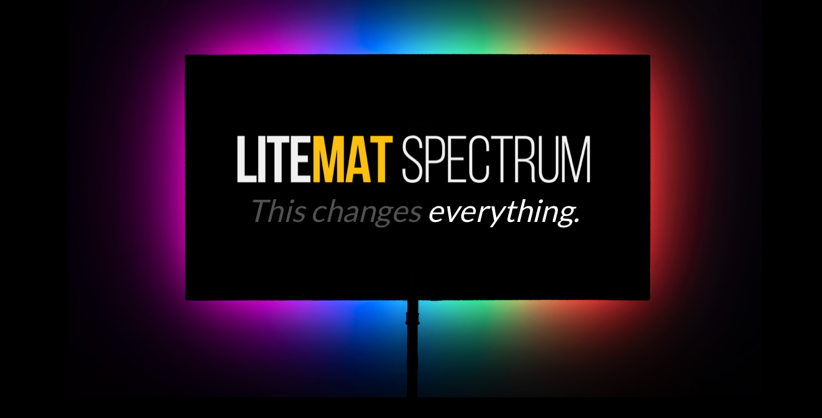Litemat Spectrum by Litegear
Spectrum. Forgetting the obvious rainbows, prisms and so on, what does spectrum mean to you?
For me it takes me back, way back. I was awaiting my birth when the Jerry Anderson series Captain Scarlet was first broadcast in 1967. I grew up watching it and playing with my older brother’s toy cars from the series. I recall the Spectrum pursuit vehicle (SPV) in particular, I was very jealous of that one. Fast forward 16 years to the young Bruce on the waiting list with Sinclair for the all new ZX Spectrum PC with its 48k of memory and 7 colours. When it (finally) arrived, it put my brothers TRS 80 from Radio Shack to shame (serves him right for rationing my enjoyment of the SPV). That unfortunately was the pinnacle of my IT understanding. I was a wizard at BASIC but a bit like matrices in maths I’ve not used it since leaving school.
The new Litemat Spectrum
But the Spectrum we are talking about is the new Litemat Spectrum from Litegear. Similar to Sinclair, it’s an upgrade from the original litemats. But unlike Sinclair when they updated the ZX81 to the Spectrum and added 7 colours, Litegear have added 360 pure colours with 100 shades of saturation. In reality the jump from the ZX81 to the Spectrum was an enormous leap in terms of PC technology. It was truly revolutionary and I think we will look back at the Litemat Spectrum in the same way – it really has changed everything.
Litemat Spectrum now available to hire from Pixipixel
A quick review of Litegear’s Litemat Spectrum
So, let’s take a look at Litegear’s attempt to make gels a thing of the past shall we.
Physically the Spectrum looks much the same as the existing Litemat range and has lost nothing in terms of its usability. It’s still small, thin, light and versatile as we have come to expect and appreciate. The main changes are all to do with performance and it’s all good news.
The Spectrum adds full colour capabilities, increased kelvin range, full spectrum desaturation of colour, +/- green correction, compliance to 709 colour space and large format pixel control. Litegear believe that technicians are going to love it and I think they are correct.
I’m going to start with the “large format pixel control” as I’ve not heard of that before. I think the term “large format pixel” is confusing to be honest. Litegear say that the Spectrum features pixels that are 340mm x 480mm. Wow, that’s certainly large (if a HD TV had pixels that size it would be over 5 kilometres wide, so I think I’m getting the wrong end of the stick). What Litegear mean is that they have split the panel into areas of individual control, with the Litemat Spectrum 1 having only one large format pixel and the Litemat 2 having two and so on. This allows for one panel to emit 2 or more different colours at the same time. This can be very useful for special effects such as police lights and the like.
Full colour desaturation is handled a little differently from the norm with the Spectrum units. Instead of just changing the strength of the colour, the Spectrums actually add white light to the equation to achieve the desaturation. The Spectrum loses nothing in terms of output power from the previous Litemats and in fact, now has a wider kelvin range for white light from 2000 degrees to 11000 degrees.
Light as the camera sees it…
By adding an extra 4 coloured LEDs to the mix (red, green, blue and amber), Litegear’s Spectrum Litemats offer highly accurate colour rendition. The amber LED is key in producing perfectly balanced colour. In fact, the Litemat can now be set to a specific camera sensor to give the most accurate white light possible (as the camera sees it) and hence the most accurate colours too. This may be little off putting at first as what you see on the set and what the camera sees are not necessarily the same. But as photographers and cinematographers, we should be used to that and getting it right in camera on set saves a heap of time and effort later on in post.
Built-in wireless DMX is always a nice thing and as you would expect, it’s now standard across the range. Power as before can be sourced from AC mains or DC battery and as the Spectrums now have the dimmers built into the head, a higher voltage can be sent down the cable allowing for longer cable runs without any power drop off. Data and power are now transmitted down the one cable too, decreasing the spaghetti of cables on set and that’s always a good thing.
I’m delighted to say that all the current accessories from the existing Litemat range (grids soft boxes etc) are compatible with the new Spectrum units.
Okay, so I’d better give it a coolness rating and I think it’s a strong 8 / 10. The improvements are fantastic, the colours spectacular and the backwards compatibility is greatly appreciated. Well done, Litegear. Good job all-around. I think if Captain Scarlet had had a light panel, he would have had one of the Litemat Spectrums.
Will you be trying the Litemat Spectrum on your next project? If you have any questions, let me know here.


